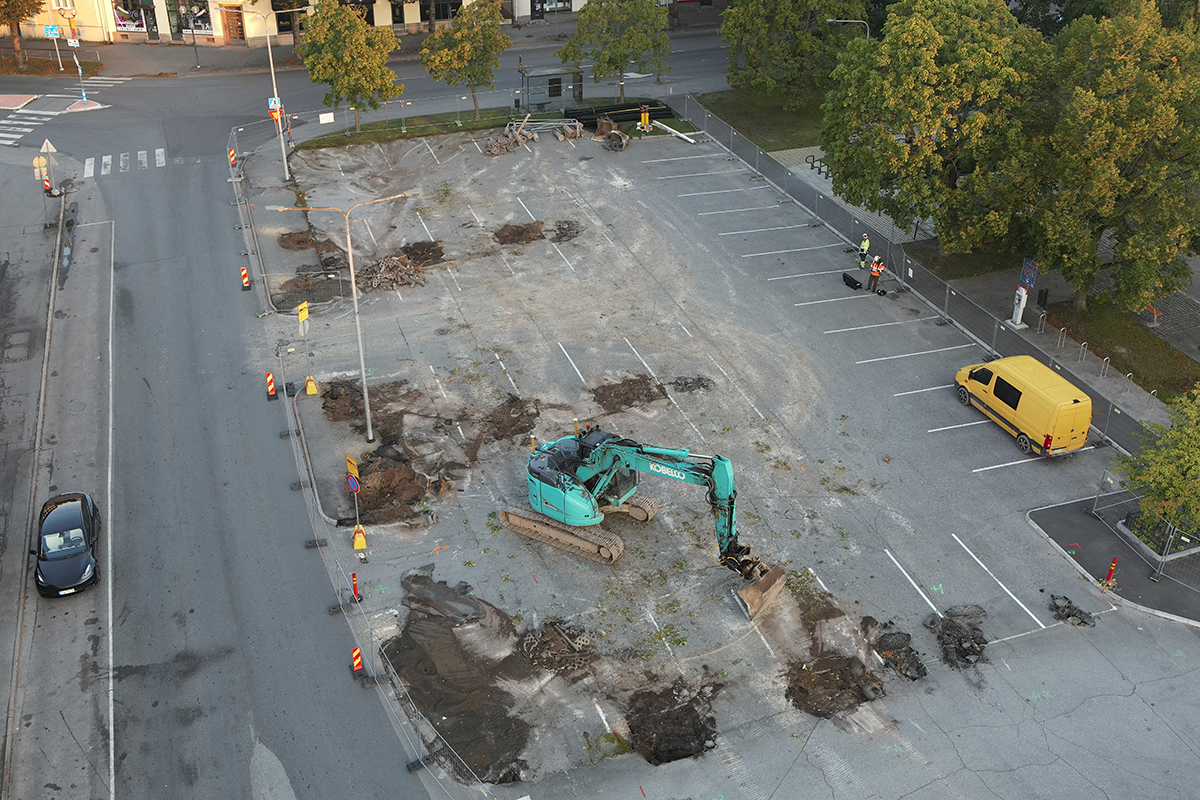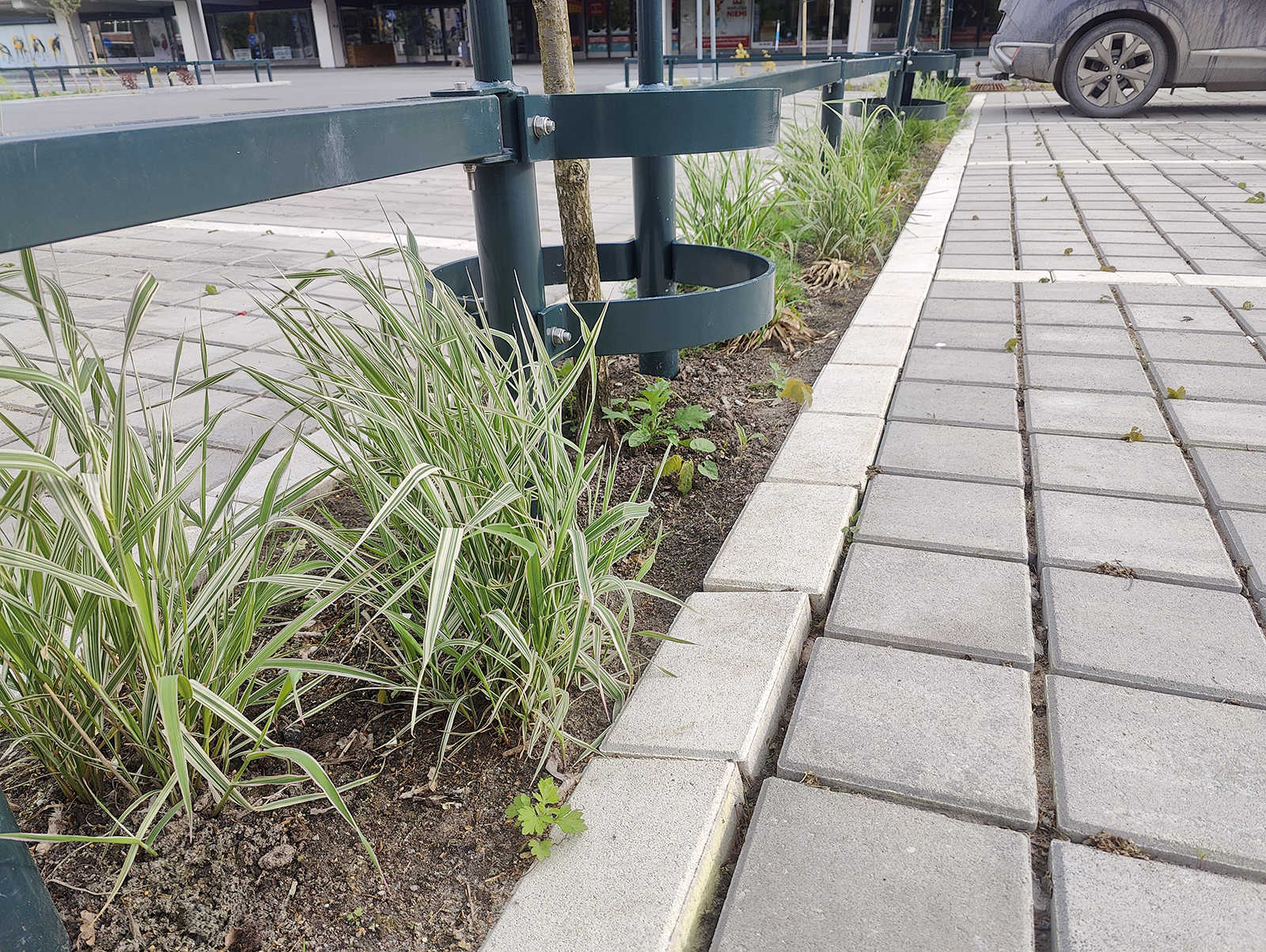We Research: Nature-based Stormwater Management in Central Square
The MUSTBE project is building seven stormwater pilot solutions in four Central Baltic countries – Estonia, Finland, Sweden and Latvia. The solutions aim to improve stormwater treatment and management by combining nature-based stormwater solutions with digital solutions. The goal of the MUSTBE project is to develop urban stormwater management multidimensionally, supporting both climate change adaptation and biodiversity. One of the pilot solutions located in Finland was completed in December 2024 in the Central Square parking area in the heart of Pori. The effectiveness of the solution has been monitored during the current year using both continuous measuring devices and traditional water analyses. Preliminary results and observations have been attained, especially in regard to stormwater management.

Stormwater contains significant amounts of nutrients and pollutants, which originate from traffic, building materials and road de-icing measures, among other things. If untreated, the pollutants carried along with it eutrophicate and cloud water bodies, and pollutants such as metals, hydrocarbons and microplastics may cause significant harm to aquatic organisms. The volume of stormwater will increase as precipitation increases due to climate change, so in addition to better management of stormwater, more attention must be paid to its quality. (Ministry of the Environment, 2023)
The Pori Central Square parking area is located in the middle of a dense city centre area, which has previously caused stormwater challenges in the area, especially in winter; the district heating line has melted snow, which has refrozen into ice, hindering the use of the area. In addition, the vegetation previously located in the area has not thrived, as the compacted soil weakened the water and oxygen supply of the roots, and the vegetation was located higher than the surrounding ground, preventing full utilisation of stormwater.
Nature Guides Solutions – Green Lanes, Plant Embankments and Permeable Pavers Take Centre Stage
The pilot solution for the Central Square parking area primarily aims to improve stormwater management, but the solution also combines the well-being of green areas, traffic needs, stormwater treatment and limitations posed by the surrounding infrastructure. The green lanes in the Central Square parking area were renewed and built on structural soil. The structural soil ensures sufficient water and oxygen supply for planted vegetation and trees in paved areas. The absorption and filtration of stormwater is aided by green lanes and plant embankments, to which water is directed using the slopes of the ground. In addition, the parking area has permeable pavers instead of just asphalt to further enhance the absorption of stormwater into the soil and the roots of vegetation. Any excess stormwater filtered by the green lanes and plant embankments is directed further into the stormwater drainage network.

At the beginning of the MUSTBE project, the target for the Central Square stormwater solution was set at 60% reduction in suspended solids, 40% reduction in nitrogen and 40% reduction in metals compared to the baseline. Since the solution was completed, the effectiveness of the Central Square has been continuously monitored by measuring the flow rate, salinity, temperature and electrical conductivity of the outflowing water, as well as the ground moisture in the area. The assessment of effectiveness has been supported by traditional water samples, which are used to analyse the concentrations of nutrients, hydrocarbons, metals and pathogens in both the water entering and leaving the solution. In addition, the assessment has utilized data from precipitation and studied, among other things, its impact on electrical conductivity and water quality.
First Observations: Efficient Absorption and Learning About Water Quality
The Central Square pilot solution has proven to be particularly effective in terms of stormwater management and absorption. During the heaviest rainfall events, there has been no flooding or major puddling in the area. The biggest example of the solution's stormwater management efficiency can be found in late 2024, when the Satakunta region experienced stormwater flooding due to heavy rainfall combined with melting snow – however, no stormwater problems occurred in the Central Square parking area. The excess stormwater that flows through the structure flows in the overflow well. The biggest challenge in terms of water quality has been that not enough water has accumulated in the overflow well; it has been difficult to obtain a fresh sample of the overflow well water, and therefore the exact effects of vegetations and embankments on water quality are not yet known. However, the positive thing is that the solution in the Central Square parking area has managed to absorb all incoming water, and overflows are likely to occur in winter when the ground is frozen and only for short periods. Part of the reason for the good absorption efficiency is the sandy subsoil.

Although it has been difficult to obtain water samples from the overflow water, preliminary results have still been obtained on the water quality. Monitoring of the effectiveness has shown that dry periods and the length of rainfall cycles have a significant impact on the leaching of harmful substances. The highest concentrations of metals, nutrients, hydrocarbons and pollutants have occurred especially with heavy rainfall following long dry periods, while rainy periods dilute the stormwater, leading to lower concentrations of pollutants. The range of these possible observed pollutant concentrations can be used to assess the potential environmental risks of stormwater and the times of the highest pollutant discharges.
Monitoring the effectiveness of the Central Square solution will continue until the end of the project in 2026. The aim of future water analyses is to map a more comprehensive picture of the operation and effectiveness of the pilot solution, especially regarding water quality.

Nature-Based Stormwater Solutions Increasing Urban Resilience
The pilot solution in Pori's Central Square is an example of the possibility to combine more efficient stormwater management, different objectives such as the city’s strategic goals, surrounding infrastructure and public transportation, as well as the increase of green areas in urban environments in dense urban communities. The successes and lessons learned from the pilot solution in the Central Square have been collected into a manual of solutions prepared in the project, which contains information on all seven project solutions, their design, procurement and implementation. The manual of solutions aims to enable wider implementation of the solutions, and its first version is available on the MUSTBE project website.
Climate change will increase pressure for more efficient stormwater management and treatment. In Finland, short-duration heavy rainfall may increase with climate change, causing an increased risk of flash floods in urban areas, and the disruption of infrastructure and traffic, among other things. (Utriainen et al., 2025, p. 107) Urban resilience must therefore be increased in order to be able to adapt to the impacts of climate change.
Did You Know?
- Stormwater is rainwater and snowmelt drained from yards and streets, which is generated especially in the built environment, where surfaces are most often covered with impermeable asphalt or paving (Finnish Environment Institute, 2019).
- Stormwater is most often discharged into the ground by absorption, into ditches or into waterways via stormwater drainage network. (City of Pori, n.d.). Stormwater from the stormwater drainage network is discharged untreated into nature and the sea.
- There is a total of two nature-based MUSTBE pilot solutions in Pori – you can read more about the second one here! (https://www.merilogistiikka.fi/en/we-research/we-research-monitoring-and-effectiveness-of-wetlands-nature-based-stormwater-solution/)
- MUSTBE (Multidimensional stormwater treatment in urban areas for cleaner Baltic Sea) is a project co-financed by Interreg Central Baltic -programme for 1.5.2023-30.4.2026.
Sources:
City of Pori. (n.d.) Hulevesi ja sakokaivoliete. https://www.pori.fi/asuminen-ja-ymparisto/porin-vesi/hulevesi-ja-sakokaivoliete/
Finnish Environment Institute. (28.10.2019). Mitä on hulevesi? Vesi.fi. https://www.vesi.fi/vesitieto/mita-on-hulevesi/
Utriainen, L., Virman, M., Laakso, A., Ritvanen, J., Jylhä, K. & Merikanto, J. (2025). Less frequent but more intense summertime precipitation in Finland: results from a convection-permitting climate model. Boreal Env. Res. 30: 93–109. https://doi.org/10.60910/ber2025.xv04-3n48
Ministry of the Environment. (18.1.2023). Sade- ja sulamisvesien mukana kulkeutuu vesistöihin saasteita arvioitua enemmän. Finnish Government. https://valtioneuvosto.fi/-/1410903/sade-ja-sulamisvesien-mukana-kulkeutuu-vesistoihin-saasteita-arvioitua-enemman
